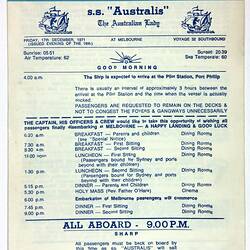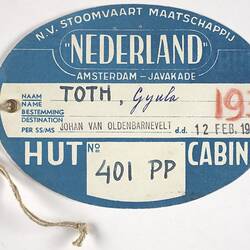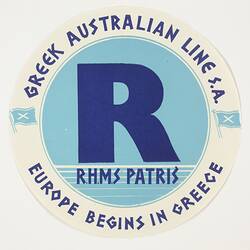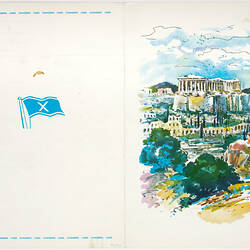Summary
History of the post World War II Migrant Ship Australis. It was the last ship to carry government assisted immigrants to Australia in 1977.
The Australis retains a significant place in Australian immigration history as the last ship to carry government assisted immigrants to Australian shores in 1977. She had the largest passenger capacity of any post World War II immigrant ship to regularly visit Australia and many passengers fondly remember her grandeur and remnants of Art Deco style.
Facts at a Glance
Dimensions: 723 x 93 ft (220.4 x 28.4 m)
Registered Tonnage: 34,449 tons gross
Service Speed: 22 knots
Propulsion: Reduction geared steam turbines / twin screws
Shipping Line: Chandris Line
History of the Ship
Originally named America, the immigrant ship Australis was designed by William Francis Gibbs and built for the North Atlantic trade - to travel between Europe and the United States.
When launched on 31 August 1939 (by Mrs Eleanor Roosevelt), she was the largest passenger vessel to have ever been constructed in the United States and provided luxury accommodation for 1202 passengers in three classes.
In the midst of World War II, she was taken over by the US Navy and converted to an American troop ship capable of carrying 8175 soldiers. Realising the impact on public sentiment should America be sunk, the American government quickly renamed the ship the USS West Point.
During the war, she visited ports in Europe, Africa and South America and was frequently attacked by Japanese forces. After 12 years on the North Atlantic trade following the war, she was sold to the Chandris Line in 1965 and christened Australis, being converted to a fully air conditioned single class ship for the Australian migrant trade. A large portion of her original interior styling was maintained, and she remained adorned with many murals and Art Deco floor coverings during her immigration years.
Immigrant Ship to Australia
The Australis left Piraeus, Greece, for her first immigrant voyage to Australia on 21 August 1965, reaching Fremantle on 6 September and Melbourne on 13 September. She made a total of 62 voyages to Australia between 1965 and 1977, travelling regularly between Britain and Australia via the Suez Canal, stopping at ports such as Aden, Port Said and Colombo.
In 1967, when the Suez was closed, she detoured around South Africa stopping at Cape Town and Durban. In 1970, while travelling between New Zealand and Suva, a fire broke out in the galley causing substantial damage, not only to the galley, but also to the ballroom and 40 cabins.
Passenger Experiences of the Journey
In the later years of the immigration boom, Australia saw many younger, single immigrants arriving with high expectations and a sense of adventure. At this time, the journey by ship was like a holiday for some passengers.
Gisela Pfab migrated from Germany in 1970:
'I was single and it turned out I had a lot of company on the boat. Soon we partied every night and didn't get to bed until in the early morning. As a result we missed our English classes most of the time.'
For others, the journey on the Australis was a pathway to freedom from political upheaval in their home country and the beginning of a new life.
Rosemarie Draper migrated from Britain in 1976, but is originally from Burma:
'Mum retained her dream to live in Australia and kept it alive for 12 years. In November 1976, we farewelled our family and friends and headed to Southampton to get aboard the Australis and begin the new phase of our lives.'
Her Final Voyage
After her final voyage to Australia on 18 November 1977, the Australis was sold to Venture Cruise Lines and again named America. After a number of unsuccessful cruises, she was sold back to the Chandris Line, with plans to cruise the Mediterranean. At this time she was christened Italis, but after only three voyages, she was laid up.
After a long period of idleness, she was taken under Panamanian ownership and named Alferdoss, but in 1988 had to be run aground near Piraeus to stop her sinking.
References:
Baty, S. 1984. Ships That Passed - The Glorious Era of Travel to Australia and New Zealand. Reed Books Pty Ltd. Frenchs Forest.
Plowman, P. 1992. Emigrant Ships to Luxury Liners. New South Wales University Press.
Kensington. Stodden, K. 2003 (October). Appendix A - Tally of Voyages. Prepared for the Ship Reunion Lecture. Immigration Museum, Melbourne.
More Information
-
Keywords
-
Authors
-
Article types










